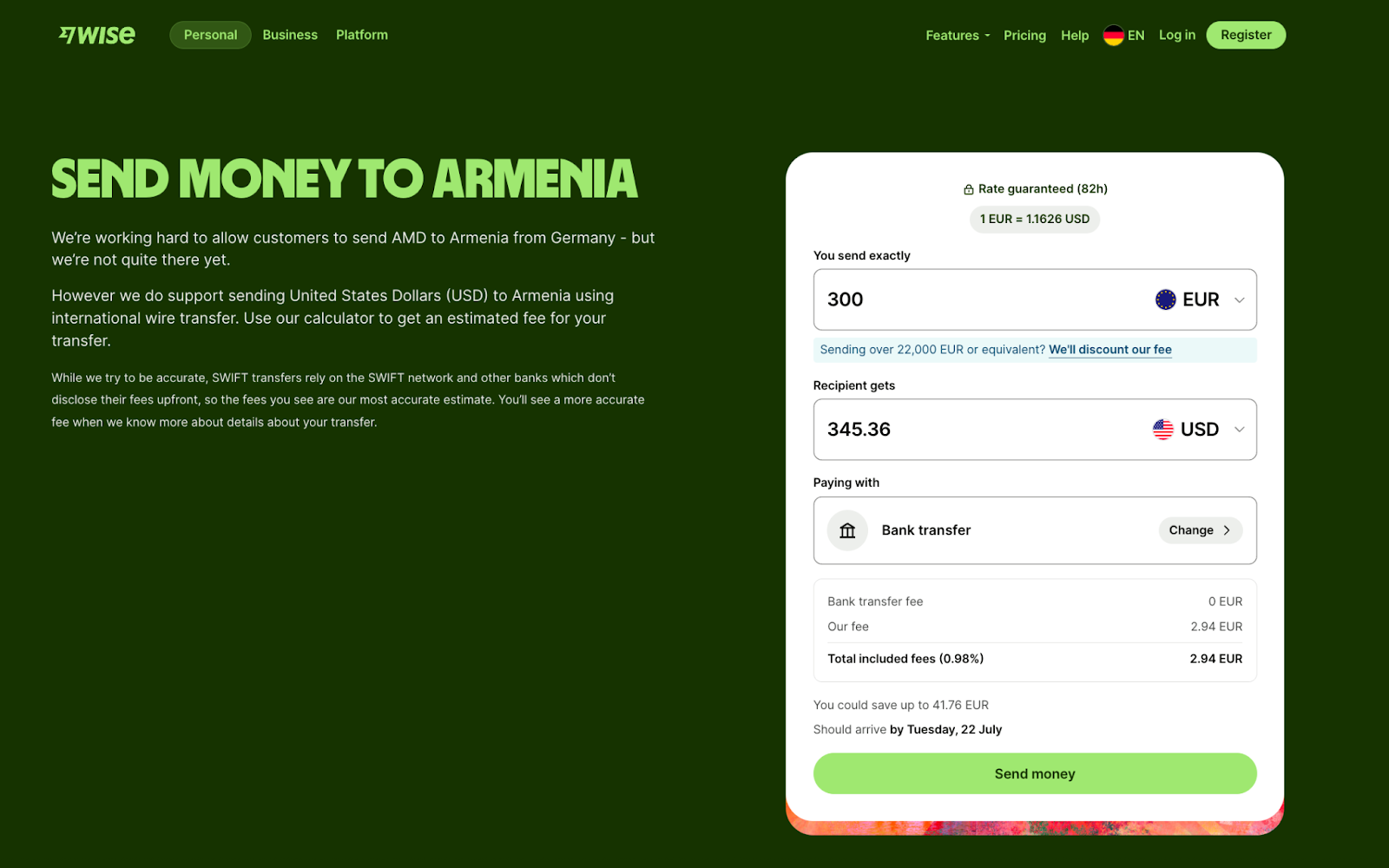Best Ways to Send Money to Armenia (and What to Avoid): the Ultimate Guide
From SWIFT to crypto, here’s how to send money to Armenia quickly, safely, and without unexpected fees or delays.
July 28, 2025
July 28, 2025

Sending money to Armenia is fairly straightforward, but choosing the right method isn’t always. Between different apps, fees, limits, and local regulations, it can be tricky to know where to start. This article will walk you through the main reasons people send money to Armenia, your best options for doing it safely and cost-effectively, and the key things to keep in mind.
Why send money to Armenia?
There are plenty of reasons why you may want to send money to Armenia. Maybe you have family in Yerevan, or you’re paying a contractor for some work they’ve done for you.
Or maybe you’re sending it to yourself after relocating. Over the past few years, Armenia has gained popularity among expats and remote workers, especially those from the EU, UK, and US who can stay visa-free for up to 180 days a year. While it doesn’t offer a formal digital nomad visa, the ease of entry, low cost of living, and close-knit creative and tech communities have made Yerevan a rising destination for independent professionals.
Some considerations to keep in mind
If you’re already sending money abroad, you may be accustomed to certain platforms that are not available in Armenia. For example, global giant Western Union exited the Armenian market in 2008 due to an Armenian Central Bank decision. PayPal also operates only partially – you can’t receive funds. Even for platforms that are fully functional in Armenia, not all of them support the local currency, dram, meaning your recipient may lose money on conversions.
Then there’s also the issue of sanctions. Some financial institutions in Armenia are subject to international sanctions, for example, over their ties to Iran or Russia. So, obviously, you will not be able to send money to a sanctioned bank from abroad.
Lastly, there are also non-Armenia specific issues, like bank fees, exchange rate markups, and delivery delays. But this is unfortunately the case with international transfers everywhere.
Here are some of the most common ways to send money to Armenia — each with its own pros, cons, and quirks. When deciding which one to use, think about what works best for your budget, timeline, and your recipient’s needs. It’s not just about speed or cost — choose a platform that’s upfront about fees, plays by the rules, and takes security seriously. Avoid anything with shady conversions or surprise charges.
Main methods for sending money to Armenia
Let’s explore some of the most common methods of sending money to Armenia from abroad.
SWIFT
When you send money via SWIFT, the funds don’t travel straight from your bank to the recipient’s. Instead, it’s like a secure chain of messages passed between financial institutions — each one confirming and processing the request until the money reaches its final destination. It’s one of the oldest and commonly used methods for sending money abroad.
To make a SWIFT transfer to Armenia, you’ll need the recipient’s full banking information — typically their name, account number or IBAN, and the BIC/SWIFT code of their bank. You can initiate the transfer through your online banking app or in person at a bank branch. Be sure to enter all the details accurately, choose who will pay the transfer fees, and confirm the transaction. The good news is that most major Armenian banks — including Ameriabank, Ardshinbank, and ACBA — are part of the SWIFT network and accept international transfers without issue.
I run a cloud-based digital signage software company in the U.S. and frequently work with freelancers and contractors in Armenia.
We've had a few instances with SWIFT transfers experiencing delays.
{{Nikita Sherbina}}
Pros:
- Generous transfer limits. While the exact limit depends on both your bank and your recipient’s, SWIFT transfers are generally well-suited for sending large amounts of money.
- Tight security protocols. It uses advanced security systems and strict rules to make sure your money and personal details are safe during the transfer. Banks around the world trust SWIFT because it’s built to prevent fraud and keep your information secure at every step.
Cons:
- Longer transfer times. SWIFT transfers can take a few days because the money often goes through several banks, each doing their own checks and delays can happen due to time zones, weekends, or paperwork.
- High fees. Similar to long transfer times, one of the reasons SWIFT is so expensive is because multiple banks might be involved in the transfer, and each one can charge their own fee for processing it. Plus, you might get hit with extra costs for currency conversion or for choosing to cover both sides of the fee.

Wise

I run a digital marketing agency in Geneva and work with a few SEO specialists and some designers based in Armenia.
We usually pay through Wise since it is fast, clear on fees, and easy for our partners to receive in their local accounts. Compared to SWIFT, Wise is much cheaper and avoids those surprise charges that come up with traditional banks.
Overall, Wise has been the most reliable option for us and keeps everyone happy on both sides. We stick to it regardless of project size to keep things simple and avoid stress later.
{{Ramzy Humsi}}
Wise (previously TransferWise) is a popular online platform for international money transfers. It’s well-liked for its transparent fees, speedy transfers, mid-market exchange rates, and easy-to-use interface.
Wise was mentioned by every single expert I spoke to as I was drafting this article as the most trustworthy and affordable platform for sending money to Armenia. There is one issue, however – at the moment, Wise doesn’t support the Armenian currency, the dram. So whatever you send will arrive in US dollars.
Pros:
- No hidden charges. There are no hidden charges or surprise markups on exchange rates — what you see is what you pay.
- Speedy delivery. In many cases, the money lands in the recipient’s account within minutes.
Cons:
- Percentage-based charges. Wise calculates its fees as a percentage of the amount you’re sending, so the bigger the transfer, the more you’ll pay. While they do offer some discounts for larger amounts, the overall cost can still add up.
- No dram support. Wise doesn’t yet support AMD as a payout currency, so transfers to Armenia arrive in US dollars. This means the recipient might have to convert the money locally, which can lead to extra fees or less favourable exchange rates.
Over two dozen payments later, Wise (formerly TransferWise) is the method I trust. We track every cent like we track grant match dollars: a quick CSV export from Wise slides neatly into the budget narrative and appeases auditors.
{{Ydette Macaraeg}}
Payoneer
For larger amounts or long-term contracts, I tend to use Payoneer, as it offers more flexibility in handling different currencies.
{{Nikita Sherbina}}
Payoneer isn’t your typical money transfer service. It’s more of a global payment platform, built for freelancers, remote professionals, and businesses that need to send and receive payments across borders. It’s also officially integrated with platforms like Upwork, Fiverr, Airbnb, and Amazon.
Let’s say you run a small design studio in France and need to pay your freelance developer in Armenia. You can pay them directly to their Payoneer account using your balance or card — and they can withdraw the money to their Armenian bank. One caveat: Payoneer doesn’t support AMD, so the funds will arrive in one of Payoneer’s supported currencies, and then the recipient can transfer them to their bank and withdraw in local currency.
Transfers between Payoneer accounts are typically free and fast — often instant. But fees vary depending on how you fund the payment. If you send money using your Payoneer balance, there’s usually no charge. But if you pay by credit card or PayPal, the fee can be as high as 3.99%, usually paid by the recipient. If the recipient doesn’t have a Payoneer account, you may pay up to 3% in fees for sending directly to their bank account.
And here’s another Payoneer-specific detail: it charges an inactivity fee. If your account receives less than $2,000 in payments within a 12-month period, you’re charged a $29.95
Pros:
- Freelancer-focused tool. Payoneer is the only tool we’ll be covering in this article that was built specifically for freelancers and solopreneurs.
- Multi-currency options. You can hold balances in multiple currencies.
Cons:
- Compounded charges. You’ll get charged for things like currency conversion, withdrawals, and account inactivity — and those costs can pile up quickly.
- Business use only. Payoneer isn’t meant for personal transfers — both the sender and recipient need verified business accounts, so you can’t use it to just send money to a friend or relative.
Revolut

Revolut is a digital banking app and financial platform that lets you manage money, make international transfers, and exchange currencies — all from your phone. It started as a low-fee currency exchange service but has since expanded to include features like virtual cards, budgeting tools, crypto trading, and international transfers. Fees depend on your Revolut plan and how you fund the transfer (e.g., card vs. balance), but even with fees, it’s often faster and more affordable than traditional banks.
Revolut seems to be a popular option among Armenians – whenever you Google something like “transfer money to Armenia,” it’s usually the first option that local users mention on community boards like Reddit. As you can see in the image, the recipient gets their money in the Armenian dram, setting Revolut apart from its competitors.
Pros:
- Fast delivery. Transfers usually land quickly, especially if sent during business hours — often within minutes.
- Local currency support. Unlike some platforms that only deliver USD or EUR, Revolut supports local currency payouts.
Cons:
- Possible limits. There may be monthly transfer limits depending on your plan. There are also restrictions on how much you may send depending on the currency. Read more about Revolut’s limits here.
- Weekend markups. With some plans, Revolut adds a small markup to exchange rates on weekends, when forex markets are closed.
MoneyGram

MoneyGram is one of the world’s largest money transfer services, known for its global reach and cash pickup options. It’s been around for decades and remains a go-to option for people who prefer sending money the traditional way — either online or in person at an agent location. Your recipient can also collect the money in cash (no bank account needed) or receive it as a transfer on their card.
With Western Union no longer available in Armenia, many people have turned to MoneyGram as a reliable alternative. Similar to Revolut, MoneyGram is among the platforms that are mentioned the most frequently by Armenian users on community boards.
To make a transfer, you’ll enter the recipient’s full name (exactly as it appears on their ID), choose Armenia as the destination country, and select how the money will be received — most commonly via cash pickup. Then, you’ll pay for the transfer using your card, bank account, or cash. Once the payment is processed, you’ll get an 8-digit reference number (MTCN), which you’ll need to share with your recipient. They can then go to any MoneyGram location in Armenia and pick up the money — often within minutes — by showing their ID and quoting the number.
Pros:
- Cash pickup option. Recipients don’t need a bank account; they can collect money in person.
- Widely available. Physical agent locations across Armenia make it accessible even for those without internet or smartphones.
Cons:
- No local currency support. Transfers arrive in USD or EUR only, which may lead to extra conversion fees on the recipient’s side.
- Unpredictable fees. MoneyGram’s exchange rates often include a markup, and overall costs depend on where you’re sending from, how you pay, and how the money is received. This can make the total cost hard to estimate upfront.
Сrypto
With cryptocurrencies, you can transfer digital assets like Bitcoin or USDT without involving banks. Instead of using traditional services like SWIFT or money transfer apps, crypto transactions happen over blockchain networks — often faster and with fewer fees.
To use crypto, you’ll need a wallet or an exchange account where you can buy, store, and send digital coins securely. It can be a super-efficient way to transfer funds, especially across borders. Crypto is not a beginner-friendly option. If you're not familiar with the tools, it’s easy to run into scams, unreliable platforms, or costly mistakes.
Sometimes we use Payoneer if the freelancer already has an account there, but we avoid crypto since many of our Armenian partners are not set up for it and it can be unpredictable on timing.
{{Ramzy Humsi}}
Cryptocurrency is legal in Armenia — you’re allowed to buy, hold, and sell it, and crypto is officially treated as property. As of July 2025, a new law has introduced stricter rules: crypto platforms now need to be licensed, follow anti-money laundering (AML) regulations, and meet transparency requirements similar to banks. According to local forums, some Armenian banks may even block the recipient’s card as they try to off-ramp.
As far as crypto exchanges are concerned, Binance and Kraken are accessible (though based off-shore) to those located in Armenia. There are also some local options like Bitbanker and other similar P2P platforms that allow users to buy and sell crypto via bank transfers or cash.
Pros:
- Speedy transfers. Crypto transactions can settle in minutes
- Low fees. You can often send large sums with minimal fees — much cheaper than SWIFT or card-based transfers.
Cons:
- Difficult off-ramping. While Armenia has local exchangers, getting AMD from crypto still requires effort and comes with extra fees and KYC checks.
- Volatile prices. Unless you’re using stable coins like USDT or USDC, crypto values can fluctuate wildly before the recipient cashes out.

I’ve compiled all of the methods we just discussed in a table, so you can compare them easily side-by-side.
Are there any legal or tax considerations to keep in mind?
While no expert I spoke to highlighted any serious issues such as blocked payments, unfortunately, there are a few hurdles when it comes to larger transactions. One of them is long compliance checks.
We have not had any serious delays or blocked payments, but larger transfers over ten thousand dollars usually take a bit longer for compliance checks.
{{Ramzy Humsi}}
Others report unexpectedly high fees.
While there have been no significant issues with blocked payments, we've occasionally encountered higher-than-expected fees on larger transactions. In general, Wise has been the most reliable for everyday payments, and I've had good experiences with it overall, especially when sending smaller amounts.
{{Nikita Sherbina}}
Now, here’s where you stand in terms of local laws or taxes. If you’re sending money to someone living in Armenia — or transferring funds to yourself after moving — keep in mind that local tax rules might come into play. In general, if you spend 183 days or more in Armenia within a 12-month period, you’re likely to be considered a tax resident. If you’re a tax resident of Armenia, income from abroad may be taxed. Non-residents are only taxed on income earned within Armenia. If you’re unsure how this applies to your situation, it’s always a good idea to consult a local accountant or tax advisor.
Taxes? My partners in Yerevan report Wise's deposits show as "incoming remittances," so they simply screenshot the receipt for their accountant and declare as business income; no blocked transfers yet.
{{Ydette Macaraeg}}
To sum it all up
And that’s all there is to getting started with sending money to Armenia! No matter why you’re transferring — supporting family, paying freelancers, or funding your own life abroad — the right method can make a big difference. With the options above, you can pick what works for you and skip the stress, delays, or hidden fees.
If you’re also sending money to Belarus, Georgia, Brazil, Serbia, Argentina, Turkey, and Kazakhstan, not just Armenia, Solowise has you covered with handy guides and expert commentary.
FAQ
We are here to ease your working routine
Whether you're freelancing or a full-time contractor, we simplify the working process, putting you in control.
Try it free




A practical guide to raising your rates and communicating the change clearly, professionally, and without unnecessary stress.

Check our guide about the best side hustles with a list of 15 second jobs at night from home for you to make more money every month.

Get tips and advice on how to build a strategy for your solopreneur social media.

.JPG)